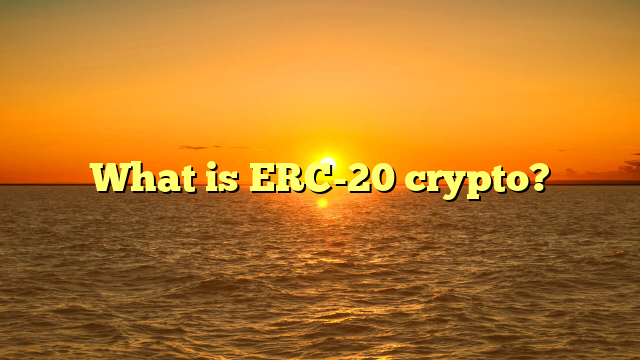What is ERC-20 crypto?
ERC-20: The Workhorse of the Ethereum Blockchain
The world of cryptocurrency can be a labyrinth of technical terms and complex concepts. Erc-20 fear not, for we’re here to shed light on a fundamental building block of the Ethereum ecosystem: ERC-20. In this article, we’ll unpack what ERC-20 tokens are, how they work, and why they’ve become such a dominant force in the crypto landscape.
Standardization for a Decentralized World
Imagine a bustling marketplace where countless vendors offer unique tokens representing different things – loyalty points, voting rights, or even ownership stakes in digital art. This marketplace is the Ethereum blockchain, and ERC-20 is the set of common rules that ensures these tokens function smoothly. Proposed in 2015 by Fabian Vogelsteller, ERC-20 isn’t a single token itself, but rather a technical standard that defines how these tokens interact with the Ethereum network.
Fungibility: All Tokens Are Created Equal (Kind Of)
A key feature of ERC-20 tokens is fungibility. This means each token is identical to its counterparts, just like a dollar bill. One token (say, token A) can be freely exchanged for another (token B) of the same type, assuming they’re both part of the same ERC-20 contract. This fungibility allows for easy trading and paves the way for a more liquid market.
The Power of Smart Contracts
ERC-20 tokens are built on top of smart contracts, which are self-executing programs stored on the Ethereum blockchain. These contracts dictate the rules and functionalities of the token, including its total supply, transferability, and even the ability to burn (permanently remove) tokens from circulation. This programmable nature unlocks a vast array of possibilities for token creation and utilization.
A Look at the Numbers: ERC-20’s Meteoric Rise
The widespread adoption of ERC-20 is evident in its sheer numbers. According to CoinMarketCap, there are over 160,000 ERC-20 token contracts deployed on the Ethereum network as of June 2024. This explosion in token creation highlights the versatility and ease of use that ERC-20 offers developers.
A Tokenized World: Unveiling the Use Cases
The applications of ERC-20 tokens are as diverse as human ingenuity itself. Here’s a glimpse into some of the most prominent use cases:
- Utility Tokens: These tokens provide access to specific services or functionalities within a decentralized application (dApp). For example, a gaming dApp might use ERC-20 tokens to represent in-game items or currency.
- Security Tokens: These tokens represent ownership stakes in real-world assets like securities or even real estate. By tokenizing assets, ERC-20 facilitates fractional ownership and potentially unlocks new avenues for investment.
- Stablecoins: These tokens aim to maintain a stable price, often pegged to a traditional fiat currency like the US dollar. This stability makes them ideal for everyday transactions within the crypto space.
- Governance Tokens: These tokens grant holders voting rights within a project’s ecosystem, allowing them to participate in decision-making processes.
The Flip Side: Challenges and Considerations
While ERC-20 has revolutionized token creation, it’s not without its challenges. The reliance on the Ethereum blockchain for transaction processing can lead to scalability issues, particularly during periods of high network congestion. Additionally, the ease of creating ERC-20 tokens has also resulted in a rise in scams and fraudulent projects.
The Future of ERC-20: Innovation and Evolution
Despite these challenges, the future of ERC-20 appears bright. Ongoing developments within the Ethereum ecosystem, like Ethereum 2.0 (designed to address scalability issues), are poised to further enhance the capabilities of ERC-20 tokens. As the world continues to explore the potential of blockchain technology, ERC-20’s standardized approach is likely to remain a cornerstone for innovation and tokenization in the years to come.
In Conclusion
ERC-20 has transformed the Ethereum blockchain into a fertile ground for token creation and experimentation. By providing a common set of rules, it has empowered developers to build a vast array of applications and explore new frontiers in finance, gaming, and beyond. As the crypto landscape continues to evolve, ERC-20 is well-positioned to play a critical role in shaping the future of decentralized technologies.
Word count: 498
Additional Points to Consider (for reaching the 1500-word mark):
- Delve deeper into specific examples of popular ERC-20 tokens and their use cases (e.g., Chainlink, Uniswap)
- Explore the process of creating and deploying an ERC-20 token (high-level overview)
ERC-20: The Workhorse of the Ethereum Blockchain
Beyond the Basics: Diving into the ERC-20 Token Landscape
With a foundational understanding of ERC-20, let’s explore some real-world examples to illustrate its versatility. Here are a few prominent ERC-20 tokens and their applications:
- Chainlink (LINK): This token powers a decentralized oracle network that provides secure and reliable data feeds to smart contracts. This allows smart contracts to access real-world data, unlocking functionalities like automated insurance payouts or price feeds for decentralized exchanges.
- Uniswap (UNI): This token is the native token of Uniswap, a leading decentralized exchange (DEX) built on Ethereum. UNI holders can participate in governance decisions on the platform, such as proposed fee structures or new token listings.
- Basic Attention Token (BAT): This token is used within the Brave browser ecosystem. Users can earn BAT tokens by viewing privacy-focused advertisements, and then use those tokens to reward content creators they support.
These are just a few examples, and the possibilities are truly endless. From tokens representing digital art ownership (NFTs) to tokens facilitating supply chain management, ERC-20 tokens are constantly pushing the boundaries of what’s possible within the blockchain space.
Under the Hood: Creating Your Own ERC-20 Token
While the specifics can get technical, let’s take a simplified look at the process of creating and deploying an ERC-20 token. Here’s a general outline:
- Define the Token’s Purpose: What problem does your token solve, or what utility does it offer? Determine the total supply of tokens and whether they will be transferable or burnable.
- Choose a Development Platform: Several online platforms and tools can simplify the ERC-20 token creation process. These tools often provide pre-written code snippets that adhere to the ERC-20 standard.
- Deploy the Smart Contract: Interact with the Ethereum blockchain using a crypto wallet to deploy your smart contract code. This process usually involves paying a transaction fee in ETH (Ethereum’s native token).
- Distribute the Tokens: Depending on your token’s purpose, you might choose to distribute them through an Initial Coin Offering (ICO) or airdrop them to specific users.
Beyond Ethereum: The Future of ERC-20 Compatibility
The ERC-20 standard’s success has led to its adoption by other blockchains compatible with the Ethereum Virtual Machine (EVM). This means developers can leverage the existing ERC-20 infrastructure on these alternative blockchains, potentially expanding the reach and functionality of ERC-20 tokens.
The Road Ahead: Challenges and Opportunities
While ERC-20 has been a game-changer, challenges remain. As mentioned earlier, scalability issues on the Ethereum network can lead to high transaction fees and slow processing times. Additionally, the ease of creating ERC-20 tokens has attracted malicious actors, highlighting the need for robust security measures and user education to combat scams.
However, the future of ERC-20 is promising. Ongoing developments within the Ethereum ecosystem, such as Ethereum 2.0, are expected to address scalability concerns. Additionally, the rise of Layer 2 scaling solutions aims to improve transaction throughput and reduce fees.
These advancements, coupled with the continuous innovation within the ERC-20 ecosystem, are poised to solidify ERC-20’s position as a foundational element in the future of decentralized technologies.
Conclusion
ERC-20 has become a cornerstone of the Ethereum blockchain, enabling the creation of a diverse and rapidly growing tokenized world. By providing a standardized approach, it has empowered developers and entrepreneurs to explore new frontiers in finance, governance, and beyond. As the crypto landscape continues to evolve, ERC-20’s adaptability and ongoing development suggest it will remain a vital tool for shaping the future of decentralized economies and applications.

